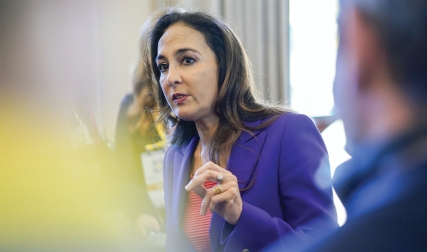Sestercentennial
Many, many thanks for the magnificent commemorative issue [January/February 2019]. The careful planning, hard work, and sheer talent behind it shine through on every page. It is a milestone and an instant classic. Hence, I shall not rush through it, as I tend to do with other issues, but will leisurely savor the full panoply of material contained within.
Nesanel Kasnett ’67
Brooklyn, New York
The 250th anniversary issue is spectacular. Beautiful job!
Michael Delizia ’64
West Bloomfield, Michigan
The sestercentennial issue is magnificent in its coverage of the College’s first 250 years. After I read through it twice, I asked myself whether anything useful might have been added. I concluded it was good the magazine said no more than it did about those early 19th-century years when, as John King Lord, class of 1868, wrote in his 1913 history of Dartmouth, the faculty was hard put to deal with “the turbulent spirits of the students.” Lord reports a flock of turkeys was found one morning in the chapel. Sometimes large farm animals were driven at night to the top of Dartmouth Hall. Now and then an instructor, on reaching his desk, found it occupied by a skunk.
There were worse pranks than installing turkeys in chapel. Francis E. Clark, class of 1873, wrote in his autobiography that during his College years, upperclassmen would occasionally steal a corpse from the Medical School and set it up in the chapel seats reserved for freshmen “to frighten the newcomers fresh from their guileless homes.”
Many decades later I was a member of the fraternity that later inspired the film Animal House. We were admittedly guilty of rowdy behavior, but we never stole a corpse.
All in all, the College is a decidedly more civilized place than it used to be; I will not say too civilized.
Peter Bridges ’53
Arlington, Virginia
In the “Can You Say Sestercentennial?” timeline, the only event from my on-campus years was the installation of Dartmouth’s first computer in 1959. The original maximum length of course titles was 16 characters, but longer titles were allowed in memo fields that described courses. Professor Robinson, the computer’s point-man, sat down muttering, “The computer will not like this!”
Regarding horning [“Artifact”], Dartmouth President Samuel Bartlett told his grandson, Don Bartlett ’59, that faculty collected their salaries by turning in enrollment tokens on “no drop” day. Midnight serenades were the only way students could remedy poor teaching skills. Student sound and fury over grades came during Vietnam War days with the coming of student evaluations. My generation still looks askance at asking lions how the lion tamer is doing!
Ronald Hufham ’59
Moscow, Idaho
I am surprised many leading living alumni weren’t on “The 25 Most Influential Alumni” list, such as Sen. Kirsten Gillibrand ’88, Gina Barreca ’79, Mindy Kaling ’01, Shonda Rhimes ’91, Laurel Richie ’81, John Donahoe ’82, and Jeffrey Immelt ’78. It’s time to create lists for the 25 most influential living alums and 25 who are no longer living.
Marianna Grossman ’80
Mountain View, California
I was disappointed with your “Most Influential” list. Of the 25 alumni selected, only two were women and only three were people of color (of which two were the aforementioned women). Dartmouth has a long way to go with regard to diversity, equity, and inclusion. DAM had an impressive community of alumni to choose from—Shonda Rhimes, Kirsten Gillibrand, Annie Kuster ’78, Laurel Ritchie, and Mindy Kaling, to name a few.
Leehi Yona ’16
Stanford, California
I very much enjoyed the entire 250th anniversary issue. Having taken many history courses at Dartmouth, a lesson I strongly remember is the importance of recalling not just the celebratory, but also errors made along the way. This issue did a wonderful job with the former. The latter, not so much.
Nelson Rockefeller ’30, No. 7 on the “Influential” list, may well have done all the things you noted, but he was also responsible for the terribly misguided, ill-conceived Rockefeller drug laws that shattered the lives of thousands of New Yorkers during nearly three decades. Well-intended? Perhaps. But wrong nonetheless. I suppose, though, that making bad mistakes is a form of influence.
Erik Roskes ’86
Baltimore
It was so disappointing to read that President Ernest Martin Hopkins was a willing participant in a shameful episode in our country’s history. His letter to J. Edgar Hoover [“Dear Dartmouth”] was not in the tradition of the independence of mind that the Dartmouth I knew aspired to teach.
David Rossman ’68
Newton Highlands, Massachusetts
The cover of the 250th anniversary issue includes the word sestercentennial, which I assume is Latin for 250th. A group planning the celebration of America’s 250th anniversary in 2026 calls itself the U.S. Semiquincentennial Commission. What do the College’s Latin scholars have to say about this apparent discrepancy?
Steve Muller ’71
Troy, New York
Ed Note: Classics department chair Margaret Graver tells DAM, “The term Dartmouth uses has good classical roots. Sestercentennial combines elements meaning half (ses = semis), three times (ter), hundred (centum), and year (annus); semiquincentennial is a more recent coinage, means the same thing, and may be more readily comprehensible to most people.”
Donor Relations
The essay by William Lamb ’67, “Blood, Guts, and Beer” [November/December 2018], about a campus blood drive boosted by Dean Thaddeus Seymour offers an example of administrative support that should be encouraged. Blood drives cultivate citizen responsibility by beginning a good habit that is always rewarding. I first gave at a Red Cross drive in December 1957 in College Hall. (I have the donor card.) I have continued ever since—my next donation will be No. 192, my 24th gallon. It’s an easy gift to make and priceless for the recipient. Maybe deans should be at the head of the line.
E. Willis Brooks ’57
Chapel Hill, North Carolina
I give a rouse for my classmate and fellow former Navy officer Bill Lamb. It took me three tries to donate my first pint of blood in College Hall in 1967. I am proud to still be at it 179 pints later. Giving blood is one of the best habits I developed at Dartmouth. Bill, thank you for your motivation!
Steve Ayres ’67
Stamford, Connecticut
Lensman
Many thanks for your article on Ralph Steiner, class of 1921 [“Restless Eye,” November/December 2018]. Professor Maurice Rapf ’35 invited Steiner to speak to the “History of Documentary Film” class in spring 1979. I was a student in the class, and Steiner was a delight. Before a group of self-important undergraduates, he was hilarious and self-deprecating and spoke out firmly for the artistic eye in art and life. The article captured him well, in particular the twinkle he brought to bear.
Jack Spellman ’80
Austin, Texas
I greatly enjoyed the article about Steiner. He was a close friend of my father’s, and I stayed with him during my visit to Dartmouth when I toured colleges. During my four years at Dartmouth I often visited Ralph and his wife, Carolyn, at their home, where I helped them split firewood in exchange for a home-cooked meal. Besides being a talented photographer, he loved engaging with young people to hear their views of the world. He would then share his own thoughtful perspectives, sprinkled with a healthy dose of quirky humor. Those times with Ralph were an important part of my Dartmouth experience.
Neil Van Dyke ’76
Stowe, Vermont
Firebrand
Caitlin Corey ’06 [“Some Like It Hot,” March/April 2018] was described as a rarity in a largely male fire department. The Dartmouth world needs to know Edith Ullman ’77 also likes it hot! After graduating with esteemed President Phil Hanlon ’77 and from a top 10 law school (Berkeley), Edy decided the fire and brimstone of the courtroom could not hold a candle to the drama at the California Department of Forestry and Fire Protection.
At a time when there were few women in this “macho” field, our classmate had all the tools: smarts, physical prowess, leadership skills, organizational and logistical intelligence, a winning (but steely strong) personality, and an Ivy League pedigree. She quickly rose through the ranks and retired as one of the few women, at the time, to reach the rank of battalion chief in California. Kudos to Edy for paving the way for women such as Caitlin 30 years later.
I will say, tongue only slightly in cheek, that her experience in the second class of women at our venerable college probably fortified her along the way.
Cathy Burnweit ’77
Miami
Last Measure
Dartmouth is extremely adept at imploring us to give money to our beloved College while we’re alive, but when we’re dead, we are not remembered.
Before 2010 DAM published a list of dead classmates and short obituaries of many. Most other Ivies publish obits in print and online, but Dartmouth obits are only online and difficult to find, at best. Unless class representatives take it upon themselves to submit them, respectful memories of former classmates do not exist.
There is a simple remedy to this vexing problem: A college with a $784-million operating budget should free up a relatively small amount to hire a part-time obituary writer, so at least some classmates can be afforded the last measure of respect in DAM, as well as online.
Ted Tapper ’61, DMS’62
Merion, Pennsylvania



